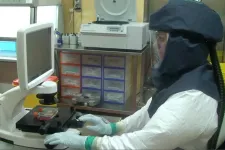(Press-News.org) Challenging the idea that older people with shorter life expectancies should rank lower in coronavirus immunization efforts, new UC Berkeley research shows that giving vaccine priority to those most at risk of dying from COVID-19 will save the maximum number of lives, and their potential or future years of life.
The findings, published Feb. 25 in the journal Proceedings of the National Academy of Sciences, address the ethical dilemma of who should be first in line for a limited supply of vaccine shots amid a contagion that so far has killed 500,000 in the United States and 2.4 million globally.
"Since older age is accompanied by falling life expectancy, it is widely assumed that means we're saving fewer years of life," said study lead author Joshua Goldstein, a UC Berkeley professor of demography.
"We show this to be mistaken," he added. "The age patterns of COVID-19 mortality are such that vaccinating the oldest first saves the most lives and, surprisingly, also maximizes years of remaining life expectancy."
Taking age and health risks into account, Goldstein, UC Berkeley demographer Kenneth Wachter and Bucknell University mathematician Thomas Cassidy conducted an analysis of life expectancy in the United States, Germany and South Korea in the face of the yearlong coronavirus pandemic.
They based their calculations on the number of lives potentially saved from being vaccinated, multiplied by the life expectancy of those vaccinated. For example, if 1 million vaccinations saved 1,000 lives, and those vaccinated people, on average, were projected to live another 20 years, the total number of years of life saved would be 20,000.
The mathematical arguments upon which they based their conclusion apply not just to a few countries, but generally around the globe, the researchers said.
"Allocating scarce COVID-19 vaccine doses involves many tradeoffs. However, a conflict between minimizing the count of deaths and maximizing remaining life is not one of them," Goldstein said.
Since the approval of various COVID vaccines last fall, and their rollouts in December, a debate has been mounting over which groups to inoculate first, given limited vaccine supplies and, in many cases, chaotic distribution systems.
While some groups have argued that essential workers should take priority to keep health, education and economic systems up and running, others, such as the World Health Organization, have declined the "Years of Life Lost" criterion in ranking vaccine recipients due to older people's disproportionately higher risk of death and the perception that such an approach would be discriminatory and disrespectful.
This latest study should assuage some of those concerns, researchers said.
"Our empirical analysis shows it is easier than thought to set such fears aside and to give vaccine priority to the oldest and those in the most vulnerable states of health," according to the paper, which notes that COVID deaths rise exponentially with age.
The researchers found that the COVID death rate by age increased by about 11% per year of age in the United States, Germany and Korea. Moreover, they found that vaccinating people in their 90s would save three times as many lives as giving the same doses to people in their 80s.
"Before this study, it was suspected that there would be some intermediate age -- not too old and not too young -- which would maximize the benefit of a vaccine, in terms of person years of life saved," Goldstein said. "But surprisingly, we show this is not the case."
INFORMATION:
Scientists at UCL and the IIT -Istituto Italiano di Tecnologia (Italian Institute of Technology) have created a temporary tattoo with light-emitting technology used in TV and smartphone screens, paving the way for a new type of "smart tattoo" with a range of potential uses.
The technology, which uses organic light-emitting diodes (OLEDs), is applied in the same way as water transfer tattoos. That is, the OLEDs are fabricated on to temporary tattoo paper and transferred to a new surface by being pressed on to it and dabbed with water.
The researchers, who ...
The investigation of Electron-Positron-Ion (EPI) plasma?--?a fully ionised gas of electrons and positrons that includes astrophysical plasmas like solar winds?--?has attracted a great deal of attention over the last twenty years. A new study published in EPJ D by Garston Tiofack, Faculty of Sciences, University of Marousa, Cameroon, and colleagues, assesses the dynamics of positron acoustic waves (PAWS) in EPI plasmas whilst under the influence of magnetic fields, or magnetoplasmas.
The authors studied the changes in PAWs using a framework of Korteweg-de Vries (KdV) and modified Korteweg-de Vries (mKdV) equations finding a former led to compressive positron acoustic solitary waves (PASWs), whilst the latter resulted in the same and additional rarefactive ...
The total amount of data generated worldwide is expected to reach 175 ZB (Zettabytes; 1 ZB equals 1 billion Terabytes) by 2025. If 175 ZB were stored on Blu-ray disks, the disk stack would be 23 times the distance to the Moon. We face the urgent need to develop storage technologies that can accommodate this enormous amount of data.
The demand to store ever-increasing volumes of information has resulted in the widespread implementation of data centers for Big Data. These centers consume massive amounts of energy (about 3% of global electricity supply) and rely on magnetization-based ...
IRS refers to the application of insecticide onto the interior walls of houses.
The study, by the Wits Research Institute for Malaria (WRIM) and the London School of Hygiene and Tropical Medicine (LSHTM), was published in The Lancet on 25 February 2021.
Targeted vs blanket Indoor Residual Spraying
Malaria still represents one of the world's largest health crises, particularly on the African continent where 94% of cases and deaths occur (World Health Organization, 2020).
Most countries in southern Africa have set the elimination of malaria within their borders as a policy target.
In ...
Prior to the emergence of new mutants of the coronavirus, such as the British variant B.1.1.7, the SARS-CoV-2 variant named D614G had already mutated from the original SARS-CoV-2 pathogen that triggered the pandemic. D614G has rapidly spread to become the most abundant variant worldwide and this D614G mutation remains in all the new emerging variants. An international team including researchers from Bern has now been able to demonstrate in both the laboratory and in animal models why the D614G variant was able to gain the upper hand over the original SARS-CoV-2 virus. "Our approach ...
A study, led by researchers at the Instituto de Astrofísica de Canarias (IAC) and carried out with OSIRIS, an instrument on the Gran Telescopio Canarias (GTC), has found the most densely populated galaxy cluster in formation in the primitive universe. The researchers predict that this structure, which is at a distance of 12.5 billion light years from us, will have evolved becoming a cluster similar to that of Virgo, a neighbour of the Local Group of galaxies to which the Milky Way belongs. The study is published in the specialized journal Monthly Notices of the Royal Astronomical Society (MNRAS).
Clusters of galaxies are groups of galaxies which remain together because of the action of gravity. To understand the evolution of these "cities of galaxies" scientists look ...
Researchers from the Andalusian Centre for Molecular Biology and Regenerative Medicine (CABIMER), in collaboration with the Swiss Institute for Experimental Cancer Research (ISREC) have studied the mechanisms behind the higher tendency of people with Mulibrey syndrome to develop tumours. Their results point to the important role of the TRIM37 protein, whose absence explains the appearance of tumour cells.
Mulibrey syndrome is a so-called rare disease as it occurs in less than 5 out of every 10,000 inhabitants. Some of these diseases usually have a very definite genetic basis. ...
If light is strongly concentrated in time and space, resulting in extreme photon densities, it can enable interaction with all conceivable materials. By using these ultrashort laser foci, even transparent materials can be modified, even though they ordinarily would not interact. Short, focused laser pulses can overcome this transparency and allow energy to be deposited completely contact-free. The exact response of the material to the radiation can be very diverse, ranging from marginal refractive index changes to destructive microscale explosions that evacuate entire areas.
Using the laser pulses for optical machining allows for equally diverse material modification, such as separating or joining using the same laser system. Due to the extremely short exposure time and low degree ...
Based on a manual recently discovered in a 3,500-year-old medical papyrus, University of Copenhagen Egyptologist Sofie Schiødt has been able to help reconstruct the embalming process used to prepare ancient Egyptians for the afterlife. It is the oldest surviving manual on mummification yet discovered.
In ancient Egypt, embalming was considered a sacred art, and knowledge of the process was the preserve of very few individuals. Most secrets of the art were probably passed on orally from one embalmer to the other, Egyptologists believe, so written evidence is scarce; until recently, only two texts on mummification had been identified.
Egyptologists were therefore surprised to find a short manual on embalming in a medical text that is primarily concerned with ...
"Everyone's unique" is a popular maxim. All people are equal, but there are of course individual differences. This was no different with dinosaurs. A study by researchers at the University of Bonn and the Dinosaur Museum Frick in Switzerland has now revealed that the variability of Plateosaurus trossingensis was much greater than previously assumed. The paleontologists examined a total of 14 complete skulls of this species, eight of which they described for the first time. The results have now been published in the scientific journal "Acta Palaeontologica Polonica".
Plateosaurus lived during the Late Triassic, about 217 to 201 million years ago. "With well over 100 skeletons, some of them completely preserved, ...





